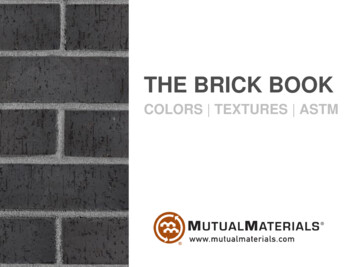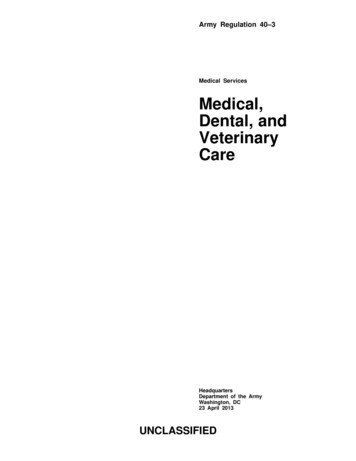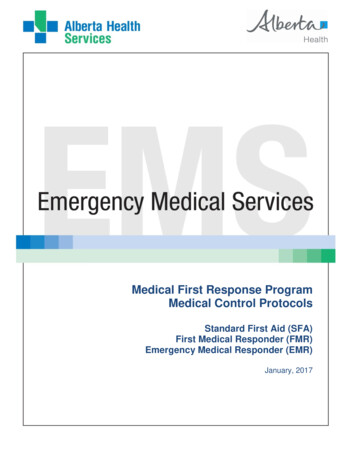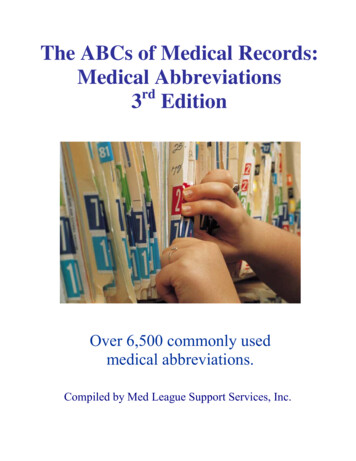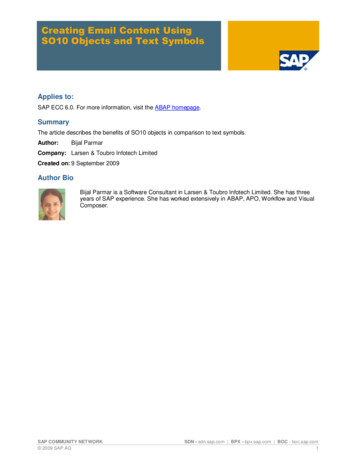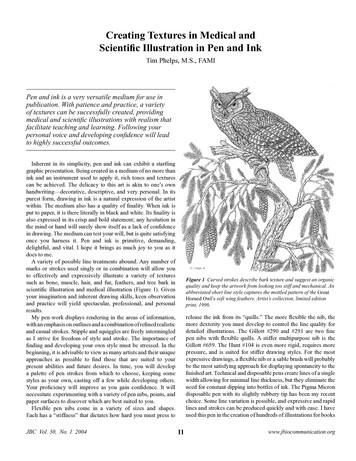
Transcription
Creating Textures in Medical andScientific Illustration in Pen and InkTim Phelps, M.S., FAMIPen and ink is a very versatile medium for use inpublication. With patience and practice, a varietyof textures can be successfully created, providingmedical and scientific illustrations with realism thatfacilitate teaching and learning. Following yourpersonal voice and developing confidence will leadto highly successful outcomes.Inherent in its simplicity, pen and ink can exhibit a startlinggraphic presentation. Being created in a medium of no more thanink and an instrument used to apply it, rich tones and texturescan be achieved. The delicacy to this art is akin to one’s ownhandwriting—decorative, descriptive, and very personal. In itspurest form, drawing in ink is a natural expression of the artistwithin. The medium also has a quality of finality. When ink isput to paper, it is there literally in black and white. Its finality isalso expressed in its crisp and bold statement; any hesitation inthe mind or hand will surely show itself as a lack of confidencein drawing. The medium can test your will, but is quite satisfyingonce you harness it. Pen and ink is primitive, demanding,delightful, and vital. I hope it brings as much joy to you as itdoes to me.A variety of possible line treatments abound. Any number ofmarks or strokes used singly or in combination will allow youto effectively and expressively illustrate a variety of texturessuch as bone, muscle, hair, and fur, feathers, and tree bark inscientific illustration and medical illustration (Figure 1). Givenyour imagination and inherent drawing skills, keen observationand practice will yield spectacular, professional, and personalresults.My pen work displays rendering in the areas of information,with an emphasis on outlines and a combination of refined realisticand casual strokes. Stipple and squiggles are freely intermingledas I strive for freedom of style and stroke. The importance offinding and developing your own style must be stressed. In thebeginning, it is advisable to view as many artists and their uniqueapproaches as possible to find those that are suited to yourpresent abilities and future desires. In time, you will developa palette of pen strokes from which to choose, keeping somestyles as your own, casting off a few while developing others.Your proficiency will improve as you gain confidence. It willnecessitate experimenting with a variety of pen nibs, points, andpaper surfaces to discover which are best suited to you.Flexible pen nibs come in a variety of sizes and shapes.Each has a “stiffness” that dictates how hard you must press toJBC Vol. 30, No. 1 2004Figure 1 Curved strokes describe bark texture and suggest an organicquality and keep the artwork from looking too stiff and mechanical. Anabbreviated short line style captures the mottled pattern of the GreatHorned Owl’s soft wing feathers. Artist’s collection, limited editionprint, 1996.release the ink from its “quills.” The more flexible the nib, themore dexterity you must develop to control the line quality fordetailed illustrations. The Gillott #290 and #291 are two finepen nibs with flexible quills. A stiffer multipurpose nib is theGillott #659. The Hunt #104 is even more rigid, requires morepressure, and is suited for stiffer drawing styles. For the mostexpressive drawings, a flexible nib or a sable brush will probablybe the most satisfying approach for displaying spontaneity to thefinished art. Technical and disposable pens create lines of a singlewidth allowing for minimal line thickness, but they eliminate theneed for constant dipping into bottles of ink. The Pigma Microndisposable pen with its slightly rubbery tip has been my recentchoice. Some line variation is possible, and expressive and rapidlines and strokes can be produced quickly and with ease. I haveused this pen in the creation of hundreds of illustrations for books11www.jbiocommunication.org
Creating Textures in Medical and Scientific Illustration in Pen and Inkeliminates the need for a light box or manual transfer. A minimalamount of scratch back or line scoring can be achieved, however,with film or vellum. Each of the above surfaces will add to thedevelopment of your personal style, and so decisions regardingpens and surfaces rests squarely on your shoulders, and at yourfingertips. It is important to experiment with a variety of nibs andpens on a variety of surfaces to see which papers and pen marksare best suited to you and your personality.Important ConsiderationsSalamander Dissection (Figure 3) provides a template for thediscussion to follow. In preparation for the final illustration, a series of guidelinesshould be added to your sketch to provide a basis for line directionin the final ink rendering. This sketch becomes a roadmap for allline work to follow.Figure 2 Rapid lines and strokes can be produced quickly and easilywith disposable pens. Native Anatomy of Atrioventricular Canal,Critical Heart Disease in Infants and ChildrenChildren, Nichols et al., Mosby,1995, and second edition in press, 2004.and journal publications over the past seven years (Figure 2).Selection of the appropriate inking instrument will be dependentupon the surface you choose to use; a variety of boards andsurfaces are available for pen and ink drawing. Scratchboard isthe preferred surface for achieving the richest lines and broadesttonal range; it gives artists the ability to scratch back to whitewith knives and tools in the drawing’s darkest areas. Flexiblepen nibs work best on this surface. Scratchboard can, however,be time-intensive in board preparation, final sketch preparation,and transfer. Should you choose this approach, Essdee brand isan excellent board choice.Strathmore Bristol is another fine surface with its paper toothfor all pens and nibs, but it does not allow for scratching back intothe black areas for full tonal range like scratchboard. And, likescratchboard, it may require a transfer drawing or working ontop of a light box. Various drafting films and vellums will acceptnibs, pens, and brushes, but the ink may spread or bleed slightlydepending on the tooth or surface texture. Some films will havea longer ink drying time. Because of their translucency, film andvellum can be placed directly over your initial sketch, retainingthe spontaneity of your sketch. Inking on film or vellum alsoJBC Vol. 30, No. 1 2004Figure 3 Rendering takes shape with the use of a variety of lineweights and strokes, with continual observation of the predeterminedfocal point. Salamander Dissection, Amphibian Medicine and CaptiveHusbandry, Wright and Whitaker, Krieger, 2001. The initial sketch prepared for inking also should include arange of light and dark accent areas with midtones in between.The ink lines you will create are by now loosely based on agray scale you have formulated either directly on your sketch,or indirectly in your mind. This would include assigning certaintonal values to specific tissues as needed. It can also includemaking adjustments to tonal areas to further direct the viewer’s12www.jbiocommunication.org
Creating Textures in Medical and Scientific Illustration in Pen and Inkeyes by broadening tones in the focal area and lessening tones inareas out of focus or in the periphery. The focal area should always carry the greatest amount ofrendering with the broadest range of tone along with distinct,descriptive detail. To draw the viewer in for didactic instruction,render with broad tones in the center of the drawing and allowthe peripheral areas to fall away to lighter shades of gray. Begin with outlines in the focal area and then trail the lines tothe periphery. The lines are accented in weight with the intent todraw in the viewer. Midtone areas are lightly established withthin and carefully placed lines and then tapered out. The powerof an effective pen and ink illustration lies in not only what is putin, but also often what is left out. Rendering takes shape with the use of a variety of line weightsand strokes, with continual observation of the predeterminedfocal point. Always keep the focal point in mind with the intent ofdisplaying the broadest range of value and detail. Both highlightsand shadows will be their strongest here. Broken junction lines andlost edge lines will display aerial or atmospheric perspective.Figure 4 Use of varied line weights and cross-hatching achieves avery effective and informative use of line as tone. Detail of SunflowerVisitors, Artist’s collection, limited edition print, 1995. Move out into the periphery of the illustration with the questionof line weight strength—should more or less rendering be added?If there are areas that need to be lessened, they can be erasedentirely, shaved down, or scratched through with an X-actoblade. Lines also can trail off with short lines or dots. Areas in the main portion of the illustration may call for furtheremphasis. Cross-hatching will further strengthen or broadentones. Accents of black in recesses and shadows will impartsparkle and focus.More ExamplesIn this close-up of the sunflower (Figure 4), the use of variedline weights and cross-hatching achieves a very effective andinformative use of line as tone. By placing long streaking linesside by side with variations in thickness, the surface texture of thesunflower petal comes alive. Thin lines placed closely togetheryield a gray tone, further capturing the look of the undulatingsurface of the flower’s fragile petals. Accented outlines of varyingthicknesses complete petal edges. Short lines and cross-hatchingare used in shadow areas, providing subtle and delicate tone; theyalso provide a realistic look to the fine fur of the bumblebee.Plausible presentation of tone and texture are hallmarks ofeffective pen and ink illustration seen in the illustration of a hairfollicle (Figure 5). Each quality is determined by the thicknessof line weights, the amount of space between them, the amountof black used for accents, and the size and amount of highlights.Other factors include the application of secondary lines withcross-hatching and the amount of white of the paper remaining,anchoring the illustration. Each tissue type important to theinstructional content is shown effectively, with values assignedto delineate not only tissue-specific tone and texture, but alsodepth, light, and shadow.The Course of the Median Nerve in the Palm (Figure 6) displaysJBC Vol. 30, No. 1 2004Figure 5 Plausible presentation of tone and texture are hallmarks ofeffective pen and ink illustration seen in an illustration of a hair follicle.From Johns Hopkins Family Health Book, Harpers Resource, 1999.13www.jbiocommunication.org
Creating Textures in Medical and Scientific Illustration in Pen and Inkan effective use of the pen line and stroke to depict bone, muscle,fascia, and skin. Long parallel lines with varied thicknessesdepict the texture of muscle; thicker lines combined with thinnerones, along with the selective absence of line, display not onlyindividual fiber bundles but also light and tone. Shorter lines,along with dots and dashes, define fibrous sheaths. Squiggles,stipple, and irregular marks describe protuberances, muscleattachments, and pitting of bone. Black triangular accents at theintersection of crossing lines portray shadow recesses and givesparkle to the overall drawing. Accented outlines with sketchymarks in the hand hold the contents of the anatomy in place,framing the drawing and its educational content. The illusionof transparency is displayed from scored white lines aroundthe black lines of palmar creases-dropping structures below thesurface. This illustration is presented without labels for clarity ofartistic instruction.Only plastic accented lines and limited use of stipple areFigure 7 Only plastic accented lines and limited use of stippleare used to communicate the educational intent of this illustrationof Feline Dentition, Catnip NewsletterNewsletter, Tufts School of VeterinaryMedicine, 1996.used to communicate the educational intent of this illustrationof feline dentition (Figure 7). Outline is never one single strokeor thickness; plasticity is implied with repeated thick andthin line stroking and overlapping secondary lines and markscharacteristic of fur. Carefully spaced stipples define the rootsof the teeth, providing a gray tone. Deep outlines are cut throughand dashed to imply transparency to bone beneath the surface ofskin or fur.Both local color and texture are described by a variety of linetreatments in the shell detail from the illustration of a box turtle(Figure 8). Accented lines illustrate the growth lines and surfacetexture of the shell. Evenly spaced lines placed diagonallydescribe coloration and tone on each shell segment. Highlightsare scratched away along the ridges of the growth lines, furtherFigure 6 Effective use of the pen line and stroke and a variety of penmarks depict bone, muscle, fascia, and skin in this illustration of TheCourse of the Median Nerve in the PalmPalm, proposed artwork forT. Brushart, M.D., orthopedic text, 2004.JBC Vol. 30, No. 1 2004Figure 8 Both local color and texture are described in the shell detailby a variety of line treatments. From an illustration of an Eastern BoxTurtle. Artist’s collection, limited edition print, 1991.14www.jbiocommunication.org
Creating Textures in Medical and Scientific Illustration in Pen and Inkthe drawing. By using an X-acto knife, pen lines can be scoredand broken to further soften the look.As you become more comfortable with the medium you willloosen up with “casual” or more spontaneous strokes and marks.The casual approach is successful when it provides definition tothe intended subject’s meaning—conveying the look of muscle,fat, or bone and still expressing aesthetically the illustrator’sabilities as an artist and educator. If enough information is givenand implied, then the drawing will be successful. As you becomemore comfortable with pen and ink, this looseness will emerge.Your visual vocabulary will broaden as well, as you depict astructure and its meaning in a limited number of strokes. Someof us are natural renderers, while others of us say the most withthe least. Pen and ink can be both frustrating and rewarding at thesame time, but the medium is well worth the effort.The best examples of pen and ink display the artist’s touch—asense of the artist’s hand and personality—a vigor, vitality, andconfidence with the medium. Undaunted and unafraid to expressthrough the stroke of the pen the intensity of black and white, penand ink demands that you express yourself freely and developyour own voice and become comfortable with it. Don’t be afraid;savor the opportunity to venture into a new medium. Enjoy thesemoments of chaos tempered with creativity (Figure 10).Figure 9A Subtle lobulation isachieved with careful and deliberatestipple. Decorative dots in an orderlyfashion provide an organic andnatural texture. Dog Day CicadaCicada,Artist’s collection, limited editionprint, 1991.Figure 9B Close-up image of Dog Day Cicada on Tulip Poplar.enhancing the shell’s believable topography. Further scoring oflines softens the tone and detail in the highlighted areas.Subtle lobulation in the tulip poplar’s leaves was achievedwith careful stipple in this detail from Dog Day Cicada on TulipPoplar (Figures 9A and 9B). Decorative dots, in an orderlyfashion, were situated in patterns throughout each leaf; largerdots and clusters of smaller ones provide an organic and naturaltexture. The flat arrangement of the leaves was purposeful,providing an interplay of positive and negative spaces thatcontribute to overall design. Curved parallel lines in the barkdefine form and texture; craggy lines characterize the texture ofthe cast-off carapace of the emergent annual cicada.Curved strokes help describe the bark texture as well as itsdirection of growth and volume in Loose in the Spruce (Figure 1).Curved ink lines suggest an organic quality and keep the artworkfrom looking too stiff and mechanical. An abbreviated short linestyle captures the mottled pattern of the Great Horned Owl’ssoft wing feathers. Repeated patterns on each feather describethe owl’s overall distinct camouflage marking. Changing linedirection and cross-hatching in patches adds visual interest toJBC Vol. 30, No. 1 2004Figure 10 Vigorous, and frenetic lines mimic the energy of jazzmusicians and their music; the liveliness of line speaks to the natureof jazz and the confidence of the artist. These Guys Wail, Artist’scollection, limited edition print, 1989.AuthorTim Phelps (thphelps@medart.jhu.edu), Associate Professor, has been teaching andillustrating for 19 years in the graduate program of Art as Applied to Medicine, JohnsHopkins, Baltimore, Md. He has received numerous regional and national awards forhis work published in textbooks, magazines, and professional journals. His artworkhas been displayed in more than 40 group and solo exhibitions created in a variety ofmedia including pen and ink, colored pencil, watercolor, and airbrush. Phelps is a PastPresident and Past Chairman of the Board for the Association of Medical Illustrators.He was the principle illustrator for the Johns Hopkins Family Health Book publishedin 1999, a contributing illustrator for the Smithsonian’s Ocean Planet, a travelingexhibit, and is a coauthor of Surgical Pathology Dissection: An Illustrated Guide, nowin its second edition. Most recently, he authored and illustrated a book on the historyof hot rod flame painting, recreating more than 300 diecast examples in small scale, inpress, 2004.15www.jbiocommunication.org
for all pens and nibs, but it does not allow for scratching back into the black areas for full tonal range like scratchboard. And, like scratchboard, it may require a transfer drawing or working on top of a light box. Various drafting fi lms and vellums will accept nibs, pens
